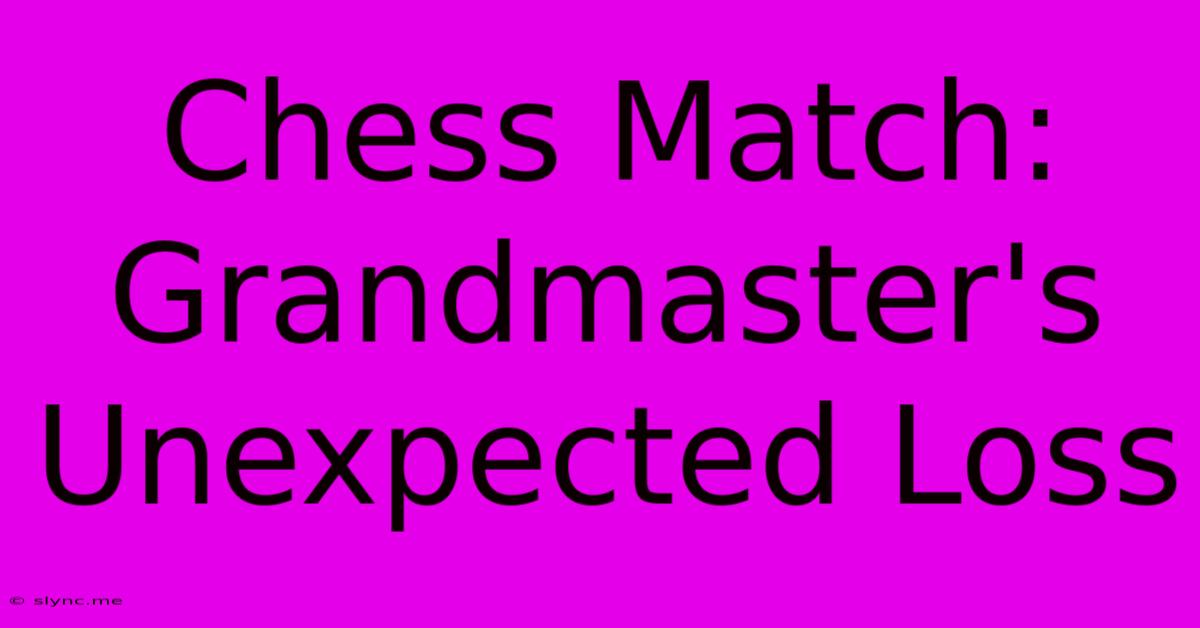Chess Match: Grandmaster's Unexpected Loss

Discover more detailed and exciting information on our website. Click the link below to start your adventure: Visit Best Website Mrs.Amykhan. Don't miss out!
Table of Contents
Chess Match: Grandmaster's Unexpected Loss
The world of chess, a game of intricate strategies and calculated risks, witnessed a stunning upset last week. Grandmaster Anya Petrova, a reigning champion known for her unwavering precision and tactical brilliance, suffered an unexpected defeat at the hands of relative newcomer, Elias Thorne. This match has sent shockwaves through the chess community, prompting discussions about the evolving nature of the game and the unpredictable nature of even the most seasoned players.
The Petrova-Thorne Match: A Clash of Styles
Anya Petrova, a player renowned for her aggressive Sicilian Defense and sharp endgame skills, faced Elias Thorne, a player characterized by his unorthodox openings and bold, almost reckless, attacking style. The contrast in their playing styles immediately set the stage for a captivating encounter. Commentators predicted a comfortable victory for Petrova, given her superior experience and ranking. However, the match unfolded in a way no one could have anticipated.
Thorne's Unexpected Gambit
From the opening moves, Thorne deviated from established theory, employing a variation of the King's Indian Defense that surprised even the most experienced analysts. This wasn't simply a deviation; it was a calculated risk, a gamble that paid off handsomely. Petrova, initially confident in her understanding of the position, found herself facing an unfamiliar and unsettling board configuration. Thorne's unorthodox approach threw Petrova off her game, forcing her into uncharacteristic errors.
A Turn of Events
The middle game was a whirlwind of attacks and counter-attacks. While Petrova attempted to regain control, Thorne relentlessly pressed his advantage, exploiting her momentary lapses in concentration with precision and aggression. Petrova's usual iron grip on the game seemed to falter, leading to several crucial tactical blunders. These mistakes, though seemingly minor individually, cumulatively shifted the balance of power dramatically in Thorne's favor.
The Decisive Moment
The decisive moment arrived in the late middle game. A seemingly innocuous pawn sacrifice by Thorne opened up a devastating attack on Petrova's king. Petrova, under pressure and facing a complex position, missed a crucial defensive resource. This oversight allowed Thorne to deliver a checkmate, securing a stunning victory against one of the world's best chess players.
Analysis and Implications
The Petrova-Thorne match highlights several key aspects of high-level chess:
- The importance of adaptability: Thorne's victory underscores the crucial role of adaptability in modern chess. Rigid adherence to established theory can be a disadvantage against players willing to innovate and experiment.
- The power of surprise: Thorne's unorthodox opening and aggressive style caught Petrova off guard, demonstrating the potent impact of surprise in a game built on calculation and prediction.
- The human element: Even the greatest chess players are human, prone to mistakes under pressure. Petrova's loss serves as a reminder that even the most meticulous strategies can fail if executed imperfectly.
This unexpected defeat has undoubtedly shaken the chess world. It raises questions about the evolving strategies and the potential for upsets in future tournaments. While Petrova's loss is certainly a setback, it also serves as a valuable lesson for both players and analysts alike. The game continues to evolve, and players must adapt to survive at the highest level. The match serves as a testament to the unpredictable and exciting nature of chess at its finest.

Thank you for visiting our website wich cover about Chess Match: Grandmaster's Unexpected Loss. We hope the information provided has been useful to you. Feel free to contact us if you have any questions or need further assistance. See you next time and dont miss to bookmark.
Also read the following articles
| Article Title | Date |
|---|---|
| Shatskiy Kontsov Realnist Chi Vigadka | Dec 13, 2024 |
| Elden Ring Nightreign Co Op Game | Dec 13, 2024 |
| Peremozhtsi The Game Awards 2024 | Dec 13, 2024 |
| Man Utd Man City Team Updates | Dec 13, 2024 |
| Allu Arjun In Custody Film Stampede Inquiry | Dec 13, 2024 |
